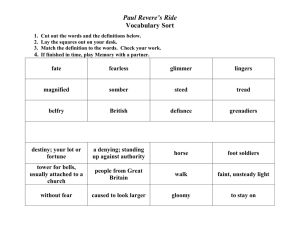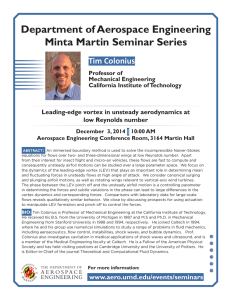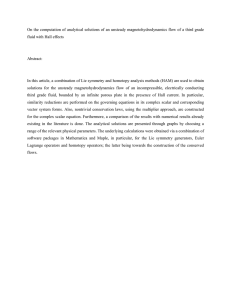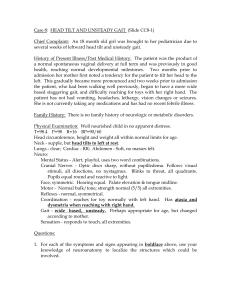Unsteady Pressure Measurements
advertisement
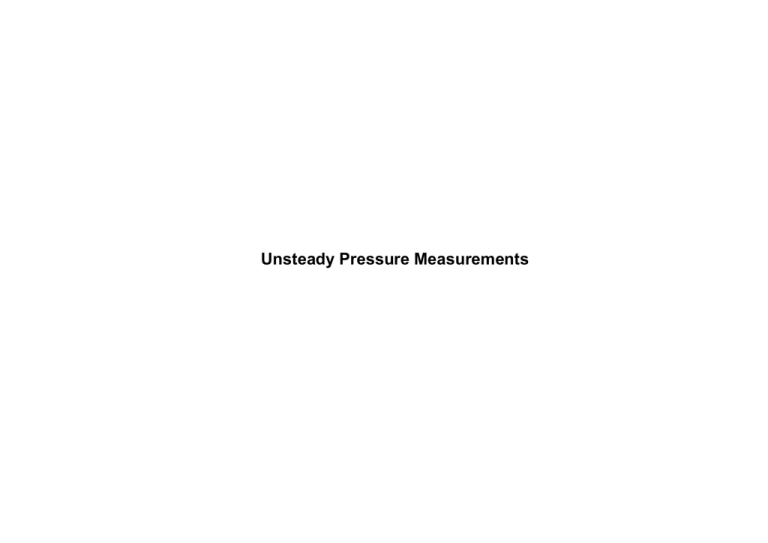
Unsteady Pressure Measurements Unsteady Pressure Measurements Quite often the measurements of p pressures has to be conducted in unsteadyy conditions. Typical cases are those of -the measurement of time-varying pressure (with periodic oscillations or step changes) -the pneumatic scanning of several different steady state pressures (using a single pressure transducer) In these cases, phenomena like the time or frequency response of the pressure measuring system (consisting of pressure tap or probe, probe pressure line, valves, transducer) and the effect of various parameters of the measuring system have to be considered. This is necessary in order to avoid measuring errors. Unsteady Pressure Measurements An enclosure where pressure is varying, as a result of any process (moving boundaries, mass-flow input, chemical reaction, heat transfer, phase change, etc…) Different cases of occurrence of unsteady pressures Unsteady Pressure Measurements An airfoil (or any other body) immersed in an unsteady mainstream, or a steady mainstream but subjected t of change of incidence, periodic or not (oscillating airfoil, or subjected to a pitch-up maneuver) Different cases of occurrence of unsteady pressures Unsteady Pressure Measurements The case of a test model (aircraft, ground vehicle, airfoil or turbomachinery blade, internal flow system) with a large number of pressure tabs, each one subjected to a steady pressure, and using a pneumatic switching device (scanning valve) to connect in sequence every tap to the same pressure t transducer, d which hi h iis th therefore f subjected bj t d tto a succession i off pressure steps. t Different cases of occurrence of unsteady pressures Unsteady Pressure Measurements In all the previous cases represented, the measured time-dependent pressure signal P will in general be different from the real time-dependent pressure Ptrue. For example, in the case of a set of pressures measured using a scanning valve, different possible results of measurements could be obtained, characterized by an oscillating or a non-oscillating non oscillating response, response with ith a small or a large damping. damping Possible results of scanning valve pressure measurements Unsteady Pressure Measurements In general, the response of a pressure measuring system y can be examined: -in the time domain or -in the frequency domain, following a usual practice adopted in the study of the transfer practice, function of any mechanical or electrical system. Unsteady Pressure Measurements When working in time domain, a pressure step is applied to the system and the output is recorded. Several possible output shapes are shown in Figure g characterized by an oscillatory or non-oscillatory behavior. It is important in all these cases to define the “response time’, i.e. that time interval after application of the pressure step after which the pressure transducer output has reasonably reached the true final steady-state value. Time response to a pressure step input Unsteady Pressure Measurements When working in frequency domain, a sinusoidal pressure variation of a given frequency is applied to the measuring system. The system output will in general also be periodic (or sinusoidal in the particular case of a linear system). One can then use the ratio of the output to input oscillation amplitudes and an output to input phase lag, plotted versus frequency to characterize the frequency response of the system. Amplification and phase lag versus frequency Unsteady Pressure Measurements Practical configurations of unsteady pressure measurements systems: Flush-mounted pressure transducers: The ideal configuration of a pressure transducer for measuring rapidly varying pressures is that of the flush-mounted transducer. transducer In this arrangement the sensing membrane of the transducer is located directly on the surface where the pressure has to be measured, thus eliminating the need for a pressure tap, and for a plastic or metal tube connecting the tap to the inner cavity of the transducer. Unsteady Pressure Measurements Practical configurations of unsteady pressure measurements systems: Flush-mounted pressure transducers: The tap, the tubing and the internal volume of the transducer, which are present in any other arrangement, generally cause a substantial increase of the response time of the pressure measuring system. Therefore, the flush-mounted transducers generally yield the minimal response time, limited only by the mechanical response of the membrane for piezo-resistive transducers or of the sensing crystal for piezo-electric piezo electric transducers. transducers Examples of pressure transducers that can be flush-mounted: -”Kistler” and “PCB” piezoelectric transducers (tip diameter of about 5mm) -”Kulite” and “Endevco” piezosensitive transducers, with semiconductor strain gages directly bounded on the sensing membrane (total tip diameter of about 2mm) Unsteady Pressure Measurements Practical configurations of unsteady pressure measurements systems: Pressure transducer pressure tap: connected to a The usual type of pressure transducers is characterized by the existence of two i t internal l volumes, l separated t d by b the th sensing i membrane, and connected to the outside by two ports. In some cases the transducer is symmetrical (e.g. “Validyne”) in other cases it is not (e.g. (e g “Statham’ Statham , with two different internal cavity volumes) Validyne DP45 pressure transducer Unsteady Pressure Measurements Practical configurations of unsteady pressure measurements systems: Pressure transducer connected to a pressure tap: One of the two ports can be the measurement port, the other being a ‘reference’ port left open -to ambient pressure( gage pressure measurement) -to vacuum (absolute pressure measurement) or both can be used as measurement ports (differential pressure measurements) Schematic representation of pressure transducer (for gage or absolute pressure measurement) Unsteady Pressure Measurements Practical configurations of unsteady pressure measurements systems: Pressure transducer pressure tap: connected to a In the case of the differential pressure measurement, a second connecting line and pressure tap must be added to the right port. Schematic representation of pressure transducer (for gage or absolute pressure measurement) Unsteady Pressure Measurements Practical configurations of unsteady pressure measurements systems: Pressure transducer connected to a pressure tap: When a pressure is applied, the membrane deforms, causing a variation of both internal cavity volumes. This variation is defined as the “displacement displacement volume volume” of the pressure transducer, transducer and together with the “cavity volume” (in the nondeformed membrane situation) characterizes the unsteady response capability of the specific pressure transducer. However, these two volume parameters alone DO NOT define the unsteady response of a pressure measuring system. This response also depends on the connecting line length and diameter, on the pressure tap dimensions, on the absolute pressure level over which a pressure variation is considered. Unsteady Pressure Measurements Pressure transducer connected to a pressure tap: Physically, time response of the measuring system is limited by the following succession of phenomena: After a pressure step increase at the pressure tap location a pressure wave will form and will travel along the connecting line towards the pressure wave will be reflected (as a compression or expansion wave wave, depending on conditions: dead dead-end end line line, or transducer with large inner volume) and will travel back and forth a number of times until it quickly damps out. In the same time, some flow will be initiated in the connecting line, and fluid will flow into the t transducer, d -to cause a pressure increase inside the transducer (the required amount of fluid, due to its compressibility, depends on the cavity volume and on the absolute pressure level) -to compensate for the membrane deformation (the required amount of fluid depends on the displacement volume and on the amplitude of pressure step) The rate at which this will occur will also depend on the pressure loss characteristics of the connecting line, line wall pressure tapping, tapping or type of pressure probe used (static, (static total, total multiplemultiple holes). This is different from the steady state situation, in which there is no flow in the connecting line, and no need to consider its pressure loss characteristics. Unsteady Pressure Measurements Pressure transducer connected to a p pressure tap: p It is absolutely wrong to speak about the time, or frequency of a specific pressure transducer. p Rather one has to speak about the time or frequency response of a measuring system (transducer, plus line, plus possible fittings, plus pressure tap, or internal flow characteristics of a pressure probe) Unsteady Pressure Measurements Practical configurations of unsteady pressure measurements systems: Multiple pressures measurement using scanning valve: When a large number of pressures has to be measured, the use of a scanning valve is a must, as it greatly reduces the required number of transducers, and therefore the total cost of instrumentation,, and also simplifies p the transducer calibration procedure. 12 position scanning valve Unsteady Pressure Measurements 48 position scanning valve Unsteady Pressure Measurements Practical configurations of unsteady pressure measurements systems: Multiple pressures measurement using scanning valve: At the moment of the switching g from one position to the next, the portion of the line connected to the next pressure tap is at the correct pressure, different from the pressure existing in the line connected to the pressure transducer. To minimize the response time of this kind of system, the length and volume of the line connecting the scanning valve to the pressure transducer have to be reduced as much as possible, possible and that the length and diameter of the lines to the pressure taps have a much smaller effect. Schematic representation of scanning valve/ pressure transducer Unsteady Pressure Measurements Practical configurations of unsteady pressure measurements systems: Multiple pressures measurement using electronic pressure scanner: An alternative to the use of scanning valves for the measurement of a large number of pressures is the use of an electronic pressure scanner. scanner This consists in a number of individual pressure transducers, assembled together in a module ((with 16,, 32 or 64 transducers each), ), each transducer individual p port being g permanently connected to the tap where pressure has to be measured. The switching from one measurement to another is done electronically, by sampling in sequence the output of each pressure transducer. transducer Electronic pressure scanner (32 transducer modules) Unsteady Pressure Measurements Multiple pressures measurement using electronic pressure scanner: Another alternative is the use of a large number of individual low cost pressure transducers, connected to a data acquisition system with a sufficiently large number or channels. channels Large number of individual transducers Supplying a digital I2C output, the differential pressure sensor measures with highest sensitivityy and accuracyy even at low differential pressures (< 10 Pa). Version: SDP600 SDP610 SDP500 SDP510 Connection: Manifold connection Tube connection M if ld connection Manifold ti Tube connection Calibrated range: -500 to 500 Pa -500 to 500 Pa 0 tto 500 P Pa 0 to 500 Pa Accuracy: 0.5 Pa + 3% of reading 0.5 Pa + 3% of reading 05P 0.5 Pa + 4 4.5% 5% off reading di 0.5 Pa + 4.5% of reading http://www.sensirion.com/en/04_differential_pressure_sensors/01_sdp600differential-pressure-sensors/00_sdp600-differential-pressure-sensors.htm Unsteady Pressure Measurements Practical configurations of unsteady pressure measurements systems: P ti l tips Practical ti for f pressure transducer t d connecting: ti In practice, the pressure tap, or the holes in a pressure probe do not have the same diameter as the pressure line. line The line could be made of a number of tubes with different diameter, connected together by adaptor fittings. . •Using Using very small pressure tap are unavoidable for some applications applications. Unsteady Pressure Measurements Practical configurations of unsteady pressure measurements systems: Practical tips for pressure transducer connecting: •Using Using large line and a very small internal volume transducer lead to a pneumatic scheme resembling that of a dead-end tube. Unsteady Pressure Measurements Practical configurations of unsteady pressure measurements systems: Practical tips for pressure transducer connecting: An incorrect fitting between the line and the transducer severely compromising the system response time. Unsteady Pressure Measurements Practical configurations of unsteady pressure measurements systems: Most pressure transducers have input ports with diameters around 4 to 6 mm, and most pressure tappings in models are done using 1 mm or 1.5 mm tubing. g For instance, below Figure depicts a common but completely wrong practice, if response time has to be minimized. Unsteady Pressure Measurements Practical configurations of unsteady pressure measurements systems: It is better to custom build a special adapter, with same diameter as the line, di tl fitt directly fitted d tto th the pressure ttransducer. d Unsteady Pressure Measurements Analysis of the pressure response of a line-cavity system The step response of the simplest line-cavity system: Figure shows schematically a pressure transducer connected to a pressure tap of same diameter as the connecting line. At time t=0, a pressure step of amplitude P0, over an initial absolute pressure Pa, is applied at tap location. location At t=0, the pressure in the line (from locations 1 to 2) and in the cavity 3 of the transducer is at the initial value Pa. The fluid in the line starts moving, and the pressure in cavity 3 will rise. line Simplest line-cavity system cavity Unsteady Pressure Measurements Analysis of the pressure response of a line-cavity system Divide problem into 2 parts Cavity analysis (Pressure rise in the cavity) Line analysis (Fl id motion) (Fluid ti ) line Simplest line-cavity system cavity Unsteady Pressure Measurements Analysis of the pressure response of a line-cavity system Fluid behaviour in line: The whole amount of fluid contained in the line, of cross sectional area S, will be subjected to a force S(P1-P2) causing it to accelerate. A dynamic balance, equating this force to the sum of fluid inertia and wall friction forces will yield: Unsteady Pressure Measurements Analysis of the pressure response of a line-cavity system Fluid behaviour in line: Assuming that the wall friction coefficient in unsteady conditions is the same as that in steady flow conditions (this is the weak point of this method), we can use the h relations l i ffor steady d pipe i flflow: where ∆P , steady state pipe pressure loss is given by the sum of a distributed pressure loss and of localized pressure losses (e.g. at pipe inlet, outlet, bends, branchings…) Unsteady Pressure Measurements Analysis of the pressure response of a line-cavity system Fluid behaviour in line: So the dynamic balance equation becomes: In the case of turbulent flow flow, and explicitly making the exit pressure loss term ξ=1: In the case of laminar flow: Unsteady Pressure Measurements Analysis of the pressure response of a line-cavity system Fluid behaviour in line: •These These first order, order non-linear non linear equations describe the unsteady flow in the line connecting pressure transducer to tap or probe. •The The choice between laminar and turbulent flow case is given by the value of the pipe Reynolds number Re=U d/ ν (smaller or larger than about 2000) Unsteady Pressure Measurements Analysis of the pressure response of a line-cavity system Fluid behaviour in cavity: To describe the increase of pressure (P3 - relative pressure with respect to absolute p pressure Pa) in the transducer cavity, y mass conservation equation q is used equating the mass flow entering the cavity to the time variation of mass contained in the cavity: where volume of the cavity Vol must be considered as a variable since the pressure transducer membrane deforms in time. Vol is i nott directly di tl a ffunction ti off titime b butt rather th off pressure P3, and d thi this llatter tt iis a function of time. Unsteady Pressure Measurements Analysis of the pressure response of a line-cavity system Fluid behaviour in cavity: A polytropic compression takes place inside the cavity: Th mass conservation The ti equation ti th then becomes: b Assuming that the pressure step P3 is small compared to initial pressure Pa, as in most cases in practice Unsteady Pressure Measurements Analysis of the pressure response of a line-cavity system Fluid behaviour in cavity: As pressure transducers are designed to be linear instruments, the quantity dVol/dP3 is a constant given by dVol/dP3 = displacement volume / transducer pressure range and d th therefore f integration i t ti off the th expression, i with ith initial i iti l condition diti P3=0 0 yields: i ld Volume flow rate Unsteady Pressure Measurements Analysis of the pressure response of a line-cavity system Fluid behaviour in cavity: Analogy between fluid flow and electricity: Fluid Electricity t 1 V = ∫ Idt C0 1 P3 = ∫ USdt C0 P, Pressure Volume flow rate t V, Voltage I, Current Fluidic capacitance due to transducer inner volume and is the parameter fully charecterizing the behaviour of the transducer volume alone. Unsteady Pressure Measurements Analysis of the pressure response of a line-cavity system Fluid behaviour in cavity: C is not only dependent on the internal volume and on the displacement volume but also in on the transducer pressure range (pressure variation volume, over which the total displacement volume occurs) and on the absolute level of pressure at which the transducer is used. Thus physically the same transducer, with a given internal volume, displacement volume and differential pressure range, will exhibit a larger capacity p y ((therefore increasing g response p time of the system) y ) at low absolute pressures Pa. Unsteady Pressure Measurements Analysis of the pressure response of a line-cavity system Combined line-cavity system: Eliminating the variable P2=P3 in the line and cavity equations, we obtain: valid in the laminar flow case, but also representing the turbulent case (with k1=0 and k2=1+k) This is a first order integro-differential equation, with initial condition U=0 at t=0 The integral can be eliminated by differentiation, obtaining the non-linear, second order differential equation with two initial conditions U=0 and dU/dt=P1/ρl at t=0 Unsteady Pressure Measurements Analysis of the pressure response of a line-cavity system Combined line-cavity system: This equation can be solved numerically by a classical single-step time-marching technique ( e.g. 4th order Runge-Kutta scheme) Once U(t), i.e. the variation in time of the average velocity in the line is known, the pressure P3 in the transducer cavity can be obtained from the equation derived previously: t 1 P3 = ∫ USdt C0 System constants: Unsteady Pressure Measurements Analysis of the pressure response of a line-cavity system Combined line-cavity system: Calculated C l l t d titime response off liline-cavity it system t (effect ( ff t off connecting ti line li di diameter t keeping k i constant its length) Unsteady Pressure Measurements Analysis of the pressure response of a line-cavity system Combined line-cavity system: Unsteady Pressure Measurements Analysis of the pressure response of a line-cavity system Combined line-cavity system: The behavior of the system changes from that of an oscillating second order system y to that of a damped second order system, then to that of a first order system. Unsteady Pressure Measurements Analysis of the pressure response of a line-cavity system Combined line-cavity system: Figure below shows results of calculations for a system that can be considered of first order, as a result of the use of a transducer with a relatively large inner volume and of a line with a relatively small diameter. Calculated and measured time response of non-oscillating line-cavity system ∆P= 200 mm Hg =6V, d=1 mm) Unsteady Pressure Measurements Analysis of the pressure response of a line-cavity system Combined line-cavity system: The figure shows the effects of varying line diameter and length, and also clearly shows the difference between the system time constant τl (based on extrapolation of the curve slope at origin) and the system response time τ (when the transducer output reaches the true value). Calculated and measured time response of non-oscillating line-cavity system ∆P= 200 mm Hg =6V, d=1 mm) Unsteady Pressure Measurements Analysis of the pressure response of a line-cavity system Combined line-cavity system: Calculated and measured time response of non-oscillating line-cavity system ∆P= 200 mm Hg =6V, d=1 mm) Unsteady Pressure Measurements Analysis of the pressure response of a line-cavity system Simplified Linear Analysis of unsteady pressure measuring systems: In some cases non-linear terms of previous second order differential equation can be neglected. This happens when two conditions are both verified: Flow inside the line must be laminar and the velocity in the line must be sufficiently low or the line is very long, or the diameter is sufficiently small so th t the that th laminar l i pressure drop d ( (proportional ti l to t the th velocity l it U) results lt to t be b much larger than the pressure drop associated with dynamic pressure losses (occurring at line exit, bends or section changes), which are proportional to U2, also in the case of laminar flow. flow In such case, the term k2 is small compared to k, and the equation can be linearized as: Unsteady Pressure Measurements Analysis of the pressure response of a line-cavity system Simplified Linear Analysis of unsteady pressure measuring systems: Fluid Poiseuille relation for the pressure drop associated with laminar flow in a pipe Electricity L: Inductance R: resistance C: Capacitance I: Current V: Voltage Ohm’ss law for an electrical resistance R Ohm Equivalent resistance of a line: According to this analogy, the resistive behaviour of a line is due to viscous pressure losses. Unsteady Pressure Measurements Analysis of the pressure response of a line-cavity system Simplified Linear Analysis of unsteady pressure measuring systems: Fluid ΔP S = Force = ρlS ΔP = ρ Electricity dU = inertia dt dI V =L dt l dQ S dt Voltage across an electrical i d t with inductor, ith iinductance d t L Dynamic equilibrium of the accelerating (decelerating) flow in a pipe Equivalent inductance of a line: L: Inductance R: resistance C: Capacitance I: Current V: Voltage l L=ρ S According to this analogy, the inductive behaviour of a line is due to inertia of the fluid contained in it. Unsteady Pressure Measurements Analysis of the pressure response of a line-cavity system Simplified Linear Analysis of unsteady pressure measuring systems: Fluid Electricity t 1 V = ∫ Idt C0 P, Pressure Q=US, Volume flow rate V, Voltage I, Current L: Inductance R: resistance C: Capacitance I: Current V: Voltage Unsteady Pressure Measurements Analysis of the pressure response of a line-cavity system Simplified Linear Analysis of unsteady pressure measuring systems: To assess the behaviour of a linearizable pressure measuring p g system, y , the q quantities R, L and C can be evaluated using the formulas and used to solve the second order linear equation. Depending on the natural frequency ωn = 1 / LC and on the damping coefficient of the system ζ = R / 2 Lω n The solution of second order equation is given in Figure, Figure showing oscillating and non oscillating behaviour. General solutions of a linear second order equation Unsteady Pressure Measurements Analysis of the pressure response of a line-cavity system Simplified Linear Analysis of unsteady pressure measuring systems: The behaviour of a line may be predominantly resistive (due to viscous losses), or predominantly inductive (due to fluid inertia), depending on the relative i importance off the h effects ff off R and d L. L L ⎛ l ⎞ ⎛ 128 l ⎞ d 2 = ⎜ ρ ⎟ /⎜ μ 4⎟= R ⎝ S⎠ ⎝ π d ⎠ 32ν Therefore, the type of behaviour of a line will not depend on its length, Therefore length but only on its diameter, and on the kinematic viscosity of the fluid contained in it. Dimensionally L/R is a time, and thus we can define the line time constant: L =τl R Unsteady Pressure Measurements Analysis of the pressure response of a line-cavity system Simplified Linear Analysis of unsteady pressure measuring systems: Analogy with electric circuit with a resistance and an inductance in series: dI V = RI + L dt with I=0 at t=0 The solution is asymptotically approaching the final steady state value V/R: where τl = L R V I = (1 − exp(−t / τ l ) ) R is the circuit time constant, characterizing the initial speed of variation of current. Therefore, to determine whether a given line has an inductive or a resistive behaviour Therefore behaviour, one has to compare the line time constant τl with typical observation time. Unsteady Pressure Measurements Analysis of the pressure response of a line-cavity system Simplified Linear Analysis of unsteady pressure measuring systems: Thus if Observation time << τl inductive effects predominate Observation time >> τl resistive effects predominate and observation time is the response time to reach steady state value. In addition, when line resistive effects predominate, the inductive second order term can be neglected in the second order system equation, which is then reduced to a first order equation: dI I R + =0 dt C Characterized by a time constant τ1=RC and a response time (time to approach final state within 1%) τr=4.6 RC Unsteady Pressure Measurements Analysis of the pressure response of a line-cavity system Simplified Linear Analysis of unsteady pressure measuring systems: A quick estimation of the behaviour of a line and pressure transducer system, approximated pp by y a linear equation, q can be conducted as follows: First calculate the response time for a first order system τ1 And the time line constant τl Then if τl << τ1 inductive effects occur only at the very beginning of the phenomenon and can be neglected so that the response time τr=4.6RC Otherwise, if τl >> τ1, inductive effects are present during all the time and the full second order equation must be used: d 2Q dQ Q + =0 L 2 +R dt dt C d 2Q 1 dQ Q + + =0 2 dt τ l dt τ lτ 1 Unsteady Pressure Measurements Analysis of the pressure response of a line-cavity system Simplified Linear Analysis of unsteady pressure measuring systems: d 2Q 1 dQ Q + + =0 2 dt τ l dt τ lτ 1 Type of solution (oscillating or not) of this equation will be determined by the sign of discrement: τl 2 Δ = b − 4ac = 1 − 4 τl Δ = 0 ⇒ 1 = 4 ⇒ τ 1 = 4τ l τ1 τl Δ > 0 ⇒ 1 − 4 > 0 ⇒ τ 1 > 4τ l τ1 τl Δ < 0 ⇒ 1 − 4 < 0 ⇒ τ 1 < 4τ l τ1 τ1 The system is critically damped Th system The t is i over-damped d d ((no oscillation) ill ti ) The system is under damped (oscillation)
